From the Open-Publishing Calendar
From the Open-Publishing Newswire
Indybay Feature
CHEMTRAILS ARE REAL!! -SENATE BILL 517 FAST TRACK To establish the Weather Modification
THE ACTUAL SEANTE BILL 517: It is the purpose of this Act to develop and implement a comprehensive and coordinated national weather modification policy and a national cooperative Federal and State program of weather modification research and development.
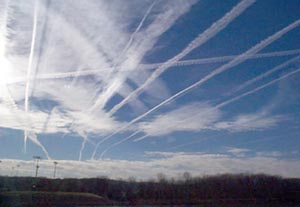
109th CONGRESS
1st Session
S. 517
To establish the Weather Modification Operations and Research Board, and for other purposes.
IN THE SENATE OF THE UNITED STATES
March 3, 2005
Mrs. HUTCHISON introduced the following bill; which was read twice and referred to the Committee on Commerce, Science, and Transportation
--------------------------------------------------------------------------------
A BILL
To establish the Weather Modification Operations and Research Board, and for other purposes.
Be it enacted by the Senate and House of Representatives of the United States of America in Congress assembled,
SECTION 1. SHORT TITLE.
This Act may be cited as the `Weather Modification Research and Technology Transfer Authorization Act of 2005'.
SEC. 2. PURPOSE.
It is the purpose of this Act to develop and implement a comprehensive and coordinated national weather modification policy and a national cooperative Federal and State program of weather modification research and development.
SEC. 3. DEFINITIONS.
In this Act:
(1) BOARD- The term `Board' means the Weather Modification Advisory and Research Board.
(2) EXECUTIVE DIRECTOR- The term `Executive Director' means the Executive Director of the Weather Modification Advisory and Research Board.
(3) RESEARCH AND DEVELOPMENT- The term `research and development' means theoretical analysis, exploration, experimentation, and the extension of investigative findings and theories of scientific or technical nature into practical application for experimental and demonstration purposes, including the experimental production and testing of models, devices, equipment, materials, and processes.
(4) WEATHER MODIFICATION- The term `weather modification' means changing or controlling, or attempting to change or control, by artificial methods the natural development of atmospheric cloud forms or precipitation forms which occur in the troposphere.
SEC. 4. WEATHER MODIFICATION ADVISORY AND RESEARCH BOARD ESTABLISHED.
(a) IN GENERAL- There is established in the Department of Commerce the Weather Modification Advisory and Research Board.
(b) MEMBERSHIP-
(1) IN GENERAL- The Board shall consist of 11 members appointed by the Secretary of Commerce, of whom--
(A) at least 1 shall be a representative of the American Meteorological Society;
(B) at least 1 shall be a representative of the American Society of Civil Engineers;
(C) at least 1 shall be a representative of the National Academy of Sciences;
(D) at least 1 shall be a representative of the National Center for Atmospheric Research of the National Science Foundation;
(E) at least 2 shall be representatives of the National Oceanic and Atmospheric Administration of the Department of Commerce;
(F) at least 1 shall be a representative of institutions of higher education or research institutes; and
(G) at least 1 shall be a representative of a State that is currently supporting operational weather modification projects.
(2) TENURE- A member of the Board serves at the pleasure of the Secretary of Commerce.
(3) VACANCIES- Any vacancy on the Board shall be filled in the same manner as the original appointment.
(b) ADVISORY COMMITTEES- The Board may establish advisory committees to advise the Board and to make recommendations to the Board concerning legislation, policies, administration, research, and other matters.
(c) INITIAL MEETING- Not later than 30 days after the date on which all members of the Board have been appointed, the Board shall hold its first meeting.
(d) MEETINGS- The Board shall meet at the call of the Chair.
(e) QUORUM- A majority of the members of the Board shall constitute a quorum, but a lesser number of members may hold hearings.
(f) CHAIR AND VICE CHAIR- The Board shall select a Chair and Vice Chair from among its members.
SEC. 5. DUTIES OF THE BOARD.
(a) PROMOTION OF RESEARCH AND DEVELOPMENT- In order to assist in expanding the theoretical and practical knowledge of weather modification, the Board shall promote and fund research and development, studies, and investigations with respect to--
(1) improved forecast and decision-making technologies for weather modification operations, including tailored computer workstations and software and new observation systems with remote sensors; and
(2) assessments and evaluations of the efficacy of weather modification, both purposeful (including cloud-seeding operations) and inadvertent (including downwind effects and anthropogenic effects).
(b) FINANCIAL ASSISTANCE- Unless the use of the money is restricted or subject to any limitations provided by law, the Board shall use amounts in the Weather Modification Research and Development Fund--
(1) to pay its expenses in the administration of this Act, and
(2) to provide for research and development with respect to weather modifications by grants to, or contracts or cooperative arrangements, with public or private agencies.
(c) REPORT- The Board shall submit to the Secretary biennially a report on its findings and research results.
SEC. 6. POWERS OF THE BOARD.
(a) STUDIES, INVESTIGATIONS, AND HEARINGS- The Board may make any studies or investigations, obtain any information, and hold any hearings necessary or proper to administer or enforce this Act or any rules or orders issued under this Act.
(b) PERSONNEL- The Board may employ, as provided for in appropriations Acts, an Executive Director and other support staff necessary to perform duties and functions under this Act.
(c) COOPERATION WITH OTHER AGENCIES- The Board may cooperate with public or private agencies to promote the purposes of this Act.
(d) COOPERATIVE AGREEMENTS- The Board may enter into cooperative agreements with the head of any department or agency of the United States, an appropriate official of any State or political subdivision of a State, or an appropriate official of any private or public agency or organization for conducting weather modification activities or cloud-seeding operations.
(e) CONDUCT AND CONTRACTS FOR RESEARCH AND DEVELOPMENT- The Executive Director, with the approval of the Board, may conduct and may contract for research and development activities relating to the purposes of this section.
SEC. 7. COOPERATION WITH THE WEATHER MODIFICATION OPERATIONS AND RESEARCH BOARD.
The heads of the departments and agencies of the United States and the heads of any other public or private agencies and institutions that receive research funds from the United States shall, to the extent possible, give full support and cooperation to the Board and to initiate independent research and development programs that address weather modifications.
SEC. 8. FUNDING.
(a) IN GENERAL- There is established within the Treasury of the United States the Weather Modification Research and Development Fund, which shall consist of amounts appropriated pursuant to subsection (b) or received by the Board under subsection (c).
(b) AUTHORIZATION OF APPROPRIATIONS- There is authorized to be appropriated to the Board for the purposes of carrying out the provisions of this Act $10,000,000 for each of fiscal years 2005 through 2014. Any sums appropriated under this subsection shall remain available, without fiscal year limitation, until expended.
(c) GIFTS- The Board may accept, use, and dispose of gifts or donations of services or property.
SEC. 9. EFFECTIVE DATE.
This Act shall take effect on October 1, 2005.
END
1st Session
S. 517
To establish the Weather Modification Operations and Research Board, and for other purposes.
IN THE SENATE OF THE UNITED STATES
March 3, 2005
Mrs. HUTCHISON introduced the following bill; which was read twice and referred to the Committee on Commerce, Science, and Transportation
--------------------------------------------------------------------------------
A BILL
To establish the Weather Modification Operations and Research Board, and for other purposes.
Be it enacted by the Senate and House of Representatives of the United States of America in Congress assembled,
SECTION 1. SHORT TITLE.
This Act may be cited as the `Weather Modification Research and Technology Transfer Authorization Act of 2005'.
SEC. 2. PURPOSE.
It is the purpose of this Act to develop and implement a comprehensive and coordinated national weather modification policy and a national cooperative Federal and State program of weather modification research and development.
SEC. 3. DEFINITIONS.
In this Act:
(1) BOARD- The term `Board' means the Weather Modification Advisory and Research Board.
(2) EXECUTIVE DIRECTOR- The term `Executive Director' means the Executive Director of the Weather Modification Advisory and Research Board.
(3) RESEARCH AND DEVELOPMENT- The term `research and development' means theoretical analysis, exploration, experimentation, and the extension of investigative findings and theories of scientific or technical nature into practical application for experimental and demonstration purposes, including the experimental production and testing of models, devices, equipment, materials, and processes.
(4) WEATHER MODIFICATION- The term `weather modification' means changing or controlling, or attempting to change or control, by artificial methods the natural development of atmospheric cloud forms or precipitation forms which occur in the troposphere.
SEC. 4. WEATHER MODIFICATION ADVISORY AND RESEARCH BOARD ESTABLISHED.
(a) IN GENERAL- There is established in the Department of Commerce the Weather Modification Advisory and Research Board.
(b) MEMBERSHIP-
(1) IN GENERAL- The Board shall consist of 11 members appointed by the Secretary of Commerce, of whom--
(A) at least 1 shall be a representative of the American Meteorological Society;
(B) at least 1 shall be a representative of the American Society of Civil Engineers;
(C) at least 1 shall be a representative of the National Academy of Sciences;
(D) at least 1 shall be a representative of the National Center for Atmospheric Research of the National Science Foundation;
(E) at least 2 shall be representatives of the National Oceanic and Atmospheric Administration of the Department of Commerce;
(F) at least 1 shall be a representative of institutions of higher education or research institutes; and
(G) at least 1 shall be a representative of a State that is currently supporting operational weather modification projects.
(2) TENURE- A member of the Board serves at the pleasure of the Secretary of Commerce.
(3) VACANCIES- Any vacancy on the Board shall be filled in the same manner as the original appointment.
(b) ADVISORY COMMITTEES- The Board may establish advisory committees to advise the Board and to make recommendations to the Board concerning legislation, policies, administration, research, and other matters.
(c) INITIAL MEETING- Not later than 30 days after the date on which all members of the Board have been appointed, the Board shall hold its first meeting.
(d) MEETINGS- The Board shall meet at the call of the Chair.
(e) QUORUM- A majority of the members of the Board shall constitute a quorum, but a lesser number of members may hold hearings.
(f) CHAIR AND VICE CHAIR- The Board shall select a Chair and Vice Chair from among its members.
SEC. 5. DUTIES OF THE BOARD.
(a) PROMOTION OF RESEARCH AND DEVELOPMENT- In order to assist in expanding the theoretical and practical knowledge of weather modification, the Board shall promote and fund research and development, studies, and investigations with respect to--
(1) improved forecast and decision-making technologies for weather modification operations, including tailored computer workstations and software and new observation systems with remote sensors; and
(2) assessments and evaluations of the efficacy of weather modification, both purposeful (including cloud-seeding operations) and inadvertent (including downwind effects and anthropogenic effects).
(b) FINANCIAL ASSISTANCE- Unless the use of the money is restricted or subject to any limitations provided by law, the Board shall use amounts in the Weather Modification Research and Development Fund--
(1) to pay its expenses in the administration of this Act, and
(2) to provide for research and development with respect to weather modifications by grants to, or contracts or cooperative arrangements, with public or private agencies.
(c) REPORT- The Board shall submit to the Secretary biennially a report on its findings and research results.
SEC. 6. POWERS OF THE BOARD.
(a) STUDIES, INVESTIGATIONS, AND HEARINGS- The Board may make any studies or investigations, obtain any information, and hold any hearings necessary or proper to administer or enforce this Act or any rules or orders issued under this Act.
(b) PERSONNEL- The Board may employ, as provided for in appropriations Acts, an Executive Director and other support staff necessary to perform duties and functions under this Act.
(c) COOPERATION WITH OTHER AGENCIES- The Board may cooperate with public or private agencies to promote the purposes of this Act.
(d) COOPERATIVE AGREEMENTS- The Board may enter into cooperative agreements with the head of any department or agency of the United States, an appropriate official of any State or political subdivision of a State, or an appropriate official of any private or public agency or organization for conducting weather modification activities or cloud-seeding operations.
(e) CONDUCT AND CONTRACTS FOR RESEARCH AND DEVELOPMENT- The Executive Director, with the approval of the Board, may conduct and may contract for research and development activities relating to the purposes of this section.
SEC. 7. COOPERATION WITH THE WEATHER MODIFICATION OPERATIONS AND RESEARCH BOARD.
The heads of the departments and agencies of the United States and the heads of any other public or private agencies and institutions that receive research funds from the United States shall, to the extent possible, give full support and cooperation to the Board and to initiate independent research and development programs that address weather modifications.
SEC. 8. FUNDING.
(a) IN GENERAL- There is established within the Treasury of the United States the Weather Modification Research and Development Fund, which shall consist of amounts appropriated pursuant to subsection (b) or received by the Board under subsection (c).
(b) AUTHORIZATION OF APPROPRIATIONS- There is authorized to be appropriated to the Board for the purposes of carrying out the provisions of this Act $10,000,000 for each of fiscal years 2005 through 2014. Any sums appropriated under this subsection shall remain available, without fiscal year limitation, until expended.
(c) GIFTS- The Board may accept, use, and dispose of gifts or donations of services or property.
SEC. 9. EFFECTIVE DATE.
This Act shall take effect on October 1, 2005.
END


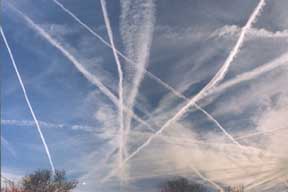
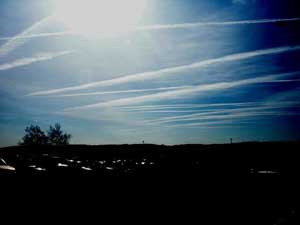
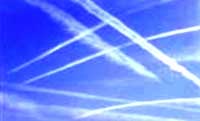
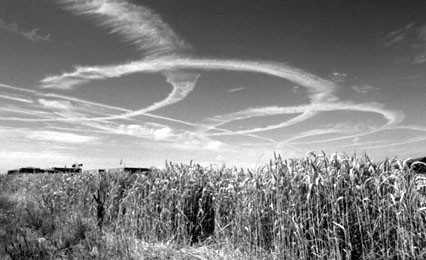
Add Your Comments
Comments
(Hide Comments)
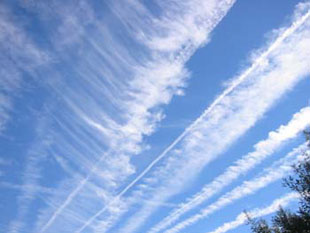
LOS ANGELES PROTEST
MARCH 23, 2006
THURSDAY - 9:00 AM
Posted on behalf of Kathy Ornstein
by Clifford E Carnicom
Feb 12 2006
Edited March 08 2006
The following scheduled protest against the aerosol operations
is announced to the public; it is recommended that this announcement be distributed to the public as widely as is possible. Thank you. CEC
--------------------------------------------------------------------------------
PROTEST DEMONSTRATION
THURSDAY, MARCH 23, 2006
TIME: 9 A.M. – 2:00 P.M.
LOCATION: 312 North Spring Street, Los Angeles, California 90012
Senator Barbara Boxer’s Office
(Corner of Spring & Temples Streets – Downtown Los Angeles)
STOP
EXPERIMENTAL WEATHER MODIFICATION
WITHOUT AGRICULTURE & PUBLIC OVERSIGHT
U.S. SENATE BILL 517 & U.S. HOUSE BILL 2995
MARCH 23, 2006
THURSDAY - 9:00 AM
Posted on behalf of Kathy Ornstein
by Clifford E Carnicom
Feb 12 2006
Edited March 08 2006
The following scheduled protest against the aerosol operations
is announced to the public; it is recommended that this announcement be distributed to the public as widely as is possible. Thank you. CEC
--------------------------------------------------------------------------------
PROTEST DEMONSTRATION
THURSDAY, MARCH 23, 2006
TIME: 9 A.M. – 2:00 P.M.
LOCATION: 312 North Spring Street, Los Angeles, California 90012
Senator Barbara Boxer’s Office
(Corner of Spring & Temples Streets – Downtown Los Angeles)
STOP
EXPERIMENTAL WEATHER MODIFICATION
WITHOUT AGRICULTURE & PUBLIC OVERSIGHT
U.S. SENATE BILL 517 & U.S. HOUSE BILL 2995
For more information:
http://WWW.CHEMTRAILS911.COM
EXECUTIVE OFFICE OF THE PRESIDENT OFFICE OF SCIENCE AND TECHNOLOGY POLICY WASHINGTON, D.C. 20502
December 13, 2005
The Honorable Kay Bailey Hutchison
United States Senator
284 Russell Senate Office Building
Washington, DC 20510
Dear Senator Hutchison:
This letter is in response to S. 517, “the Weather Modification Research and Development Policy Authorization Act of 2005,” reported out by the Senate Committee on Commerce, Science and Transportation on November 17, 2005 (Senate Report No. 109-202). While the Administration recognizes the Committee’s interest in weather modification research and development, there is a host of issues -- including liability, foreign policy, and national security concerns -- that arose in the past and should be adequately considered before the U.S. Government undertakes the coordinated national research program this legislation would require.
The Administration respectfully requests that you defer further consideration of the bill pending the outcome of an inter-agency discussion of these issues that the Office of Science and Technology Policy (OSTP) would coordinate – with the Department of Justice on legal issues, with the Department of State on foreign policy implications, with the Departments of Defense and State on national security implications, and with pertinent research agencies to consider the reasons the U.S. Government previously halted its work in this area. At the conclusion of this review, the Administration would report back to you on the results of these discussions so you are fully apprised of all possible issues associated with authorizing a new Federal program on this topic.
Specifically, the Administration believes concerns in the following areas must be better understood:
• Local Political & Legal Ramifications
o Because small scale weather modification (e.g., cloud seeding) may promote rain in one area to the detriment of another, weather modification could result in inter-state (including Indian Tribes) litigation or private citizen litigation against the modification programs.
o The legal and liability issues pertaining to weather modification, and the potential adverse consequences on life, property, and water resource availability resulting from weather modification activities, must be considered fully before the U.S. Government could take responsibility for this new research program.
• International and Foreign Policy Implications
o Small and large scale (e.g., hurricane) weather modification efforts could benefit the United States to the detriment of other countries (such as Canada or Mexico).
o Given global weather patterns, whether one country “owns” its weather so as to assert intra-border control with extra-border consequences, must be considered under present international conventions.
o The manner in which such a program could benefit or harm the present U.S. positions on foreign policy matters, such as global warming/climate change, should also be considered.
• National Security Implications
o The U.S. Government’s previous weather modification programs were part of our Cold War history; restarting them today could promote (possibly hostile) foreign responses.
o In 1978, the United States became a party to an international treaty banning the use of weather modification for hostile purposes. While modification for peaceful purposes is allowed, whether well-intentioned programs could be considered “hostile” and perceived to violate this ban should be considered.
• Research Issues
o The Department of Commerce’s National Oceanic and Atmospheric Administration’s (NOAA) primary atmospheric and meteorological research focus is on improving weather forecasting, which has proven to save lives and property. NOAA abandoned weather modification activities some time ago in favor of other research areas that more directly relate to the agency’s core mission and responsibilities.
o Redirecting funding to focus on weather modification can shift funds away from other important programs such as research to improve weather forecasting capabilities for severe weather events and research to better understand climate variability and change.
In addition to discussing these concerns on an interagency basis, and in recognition of your interest in this area, OSTP would be willing to charter a study to address the above issues. This study would be conducted by the Science and Technology Policy Institute (STPI), a federallychartered research and development center that provides objective, technical advice to OSTP. The study would address the history and current status of weather modification research. Such a study will help us understand the technical position of this field of science, the significance of the issues discussed above, and the field’s historical context.
The Administration requests that you not move forward with your legislative proposal until a better understanding can be developed of the full range of possible implications.
Thank you for your consideration.
Sincerely, John H. Marburger, III
Director cc: The Honorable Ted Stevens Co-Chair Committee on Commerce, Science, and Transportation The Honorable Daniel K. Inouye Co-Chair Committee on Commerce, Science, and Transportation
December 13, 2005
The Honorable Kay Bailey Hutchison
United States Senator
284 Russell Senate Office Building
Washington, DC 20510
Dear Senator Hutchison:
This letter is in response to S. 517, “the Weather Modification Research and Development Policy Authorization Act of 2005,” reported out by the Senate Committee on Commerce, Science and Transportation on November 17, 2005 (Senate Report No. 109-202). While the Administration recognizes the Committee’s interest in weather modification research and development, there is a host of issues -- including liability, foreign policy, and national security concerns -- that arose in the past and should be adequately considered before the U.S. Government undertakes the coordinated national research program this legislation would require.
The Administration respectfully requests that you defer further consideration of the bill pending the outcome of an inter-agency discussion of these issues that the Office of Science and Technology Policy (OSTP) would coordinate – with the Department of Justice on legal issues, with the Department of State on foreign policy implications, with the Departments of Defense and State on national security implications, and with pertinent research agencies to consider the reasons the U.S. Government previously halted its work in this area. At the conclusion of this review, the Administration would report back to you on the results of these discussions so you are fully apprised of all possible issues associated with authorizing a new Federal program on this topic.
Specifically, the Administration believes concerns in the following areas must be better understood:
• Local Political & Legal Ramifications
o Because small scale weather modification (e.g., cloud seeding) may promote rain in one area to the detriment of another, weather modification could result in inter-state (including Indian Tribes) litigation or private citizen litigation against the modification programs.
o The legal and liability issues pertaining to weather modification, and the potential adverse consequences on life, property, and water resource availability resulting from weather modification activities, must be considered fully before the U.S. Government could take responsibility for this new research program.
• International and Foreign Policy Implications
o Small and large scale (e.g., hurricane) weather modification efforts could benefit the United States to the detriment of other countries (such as Canada or Mexico).
o Given global weather patterns, whether one country “owns” its weather so as to assert intra-border control with extra-border consequences, must be considered under present international conventions.
o The manner in which such a program could benefit or harm the present U.S. positions on foreign policy matters, such as global warming/climate change, should also be considered.
• National Security Implications
o The U.S. Government’s previous weather modification programs were part of our Cold War history; restarting them today could promote (possibly hostile) foreign responses.
o In 1978, the United States became a party to an international treaty banning the use of weather modification for hostile purposes. While modification for peaceful purposes is allowed, whether well-intentioned programs could be considered “hostile” and perceived to violate this ban should be considered.
• Research Issues
o The Department of Commerce’s National Oceanic and Atmospheric Administration’s (NOAA) primary atmospheric and meteorological research focus is on improving weather forecasting, which has proven to save lives and property. NOAA abandoned weather modification activities some time ago in favor of other research areas that more directly relate to the agency’s core mission and responsibilities.
o Redirecting funding to focus on weather modification can shift funds away from other important programs such as research to improve weather forecasting capabilities for severe weather events and research to better understand climate variability and change.
In addition to discussing these concerns on an interagency basis, and in recognition of your interest in this area, OSTP would be willing to charter a study to address the above issues. This study would be conducted by the Science and Technology Policy Institute (STPI), a federallychartered research and development center that provides objective, technical advice to OSTP. The study would address the history and current status of weather modification research. Such a study will help us understand the technical position of this field of science, the significance of the issues discussed above, and the field’s historical context.
The Administration requests that you not move forward with your legislative proposal until a better understanding can be developed of the full range of possible implications.
Thank you for your consideration.
Sincerely, John H. Marburger, III
Director cc: The Honorable Ted Stevens Co-Chair Committee on Commerce, Science, and Transportation The Honorable Daniel K. Inouye Co-Chair Committee on Commerce, Science, and Transportation
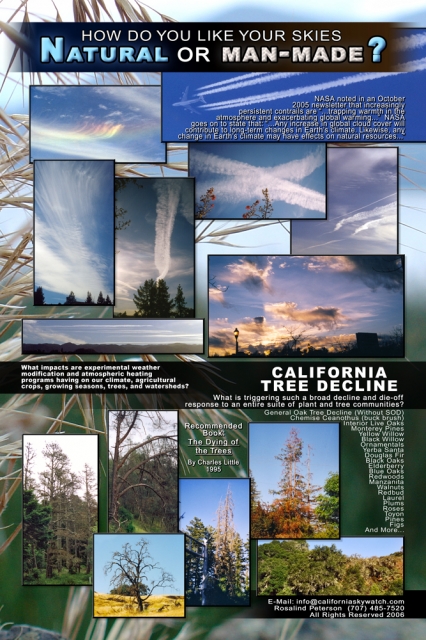
AGRICULTURE ALERT -
2006 EXPERIMENTAL WEATHER MODIFICATION BILL FAST TRACKING FOR PASSAGE IN U.S. SENATE & HOUSE OF REPRESENTATIVES
By Rosalind Peterson
U.S. Senate Bill 517 and U.S. House Bill 2995, a bill that would allow experimental weather modification by artificial methods and implement a national weather modification policy, does not include agriculture or public oversight, is on the “fast track” to be passed early in 2006.
This bill is designed to implement experimental weather modification. The appointed Board of Directors established by this bill does not include any agricultural, water, EPA, or public representatives, and has no provisions for Congressional, State, County, or public oversight of their actions or expenditures.
Weather Modification may adversely impact agricultural crops and water supplies. If the weather is changed in one state, region or county it may have severe consequences in another region, state or county. And who is going to decide the type of weather modification experimentation and who it will benefit or adversely impact?
This experimental weather modification bill will impact residents across the United States not just in California. Many current and ongoing weather modification programs (47 listed by NOAA in 2005), including the one in Wyoming that is designed to increase the snowpack, may be diverting rainwater away from Oklahoma and Texas, two states that are currently fighting fires caused by a lack of rainfall. We have no idea what the unintended consequences of the Wyoming action or other experimental weather modification programs might be now or in the future.
In addition to the experimental weather modification programs listed by NOAA, there are both private and ongoing government sponsored atmospheric testing and heating programs underway in Alaska and across the United States. Alaska Senator Stevens recently received $50 million in funding for Alaska’s atmospheric heating program.
All of these unregulated, private, government, and public weather modification programs, may also have unintended synergistic effects. Senate Bill 517 does not address these issues but intends to implement more experimental weather modification programs without a national debate or public oversight.
Artificial weather modification can impact all of us by reducing water supplies, changing agricultural crop production cycles, reducing crop production, and water availability. Since most experimental weather modification programs use chemicals released into the atmosphere the public could be subjected increasingly toxic or unknown substances that could adversely impact agricultural crops and trees.
Trimethyl Aluminum (TMA) and barium are just two of the toxic chemicals used in recent atmospheric heating and testing programs according to NASA. The Alaska H.A.A.R.P. atmospheric heating program may have the capability of changing the Jet Stream which could also change our weather.
Many private weather modification companies admit that precipitation effects may be positive or negative. Fog dispersal programs, using dry ice, liquid nitrogen, liquid propane or silver iodide may improve visibility while adversely impacting Redwood Trees along the California coast by depriving them of needed water they derive from the fog.
The increasing use of varied chemicals like aluminum (coupled with increasing air pollution), can severely impact tree health by depriving trees of water and nutrients normally absorbed through their root systems.
The December 2005 Popular Science Magazine discussed a plan to use an oil slick to stop hurricanes without noting the adverse environmental impacts of the oil used to cover the ocean.
Popular Science also noted that a private company, Dyn-O-Mat, plans to purchase jets to drop thousands of pounds of a water absorbing chemical powder (unknown substance), into hurricanes to absorb moisture that may dissipate hurricanes. There is no agriculture oversight or public hearings to determine the consequences of this and other actions or to monitor or prevent adverse impacts of this chemical once it falls on the surface of the ocean or on land.
Alaska and other areas across the United States are beginning to feel the impacts of climate change. Enormous changes are being seen in the declining health of native plant and tree communities in many areas across the United States.
NASA noted in an October 2005 newsletter that increasingly persistent contrails are “…trapping warmth in the atmosphere and exacerbating global warming…” NASA goes on to note that: “…Any increase in global cloud cover will contribute to long-term changes in Earth’s climate. Likewise, any change in Earth’s climate may have effects on natural resources…”
Global dimming and the persistent contrails, that produce man-made clouds, may have serious impacts on crop production. A recent corn crop study in Illinois shows that cloud cover reduces corn crop production while direct sunlight increases production. In addition, increasing man-made clouds may reduce the effectiveness of solar panels.
Gil Smolin, an Avian Bird Flu expert, noted on the Ron Owens Show on KGO Radio (January 5, 2006), that the flu was spread more quickly in the winter when there was a “lack of sunlight”. Would man-made clouds be contributing to the lack of sunlight which might cause the Avian Bird flu to spread more quickly at other times of the year? Experimental weather modification programs could also exacerbate this problem by changing climate patterns, increasing man-made cloud cover, and changing our weather and climate patterns.
Senate Bill 517 does not address any of these important issues. Its sole purpose is to establish an experimental weather modification policy without any agriculture or public oversight of private, military, and government programs. Without oversight or public hearings agriculture, our natural resources, and watersheds may be negatively impacted. And who will be responsible to determine the synergistic effects of these programs or pay for unintended disasters created by this experimentation. If these programs change growing seasons and interrupt the pollination process crop losses could be substantial exacerbating economic losses.
Please contact all of your elected local, state and federal officials to stop this bill in its present form. This bill needs to have appropriate agriculture and public oversight, with public hearings included, prior to any more experimental projects. We need a national dialogue on this subject before more experimentation takes place.
For more information please contact: Rosalind Peterson Post Office Box 499 Redwood Valley, California 95470 (707) 485-7520 E-Mail: info [at] californiaskywatch.com
Rosalind Peterson was born and raised on a working farm in Redwood Valley, California.The weather was the foremost factor in determining whether or not our tree crops produced fruit and nuts.
Between 1989 and 1993 Rosalind worked as an Agricultural Technologist for the Mendocino County Department of Agriculture. After leaving Mendocino County she took a position with the USDA Farm Service Agency as a Program Assistant in Mendocino, Sonoma, and the Salinas County Offices.
In 1995, she became a certified U.S.D.A. Farm Service Agency Crop Loss Adjustor working in more than ten counties throughout California. Many crop losses throughout the State can be attributed to weather related causes.
Rosalind has a BA degree from Sonoma State University in Environmental Studies & Planning (ENSP), with emphasis on agriculture and crop production.
Recommended Book: The Dying of the Trees, by Charles Little 1995
Associated Reference Articles:
http://www.medicalnewstoday.com/medicalnews.php?newsid=36105# http://www.usatoday.com/tech/science/2005-12-19-wyoming-cloud-seeding_x.htm http://www.popsci.com/popsci/science/c955700641f87010vgnvcm1000004eecbccdrcrd.html http://asd-http://www.larc.nasa.gov/GLOBE/Count/Oct2005/ConEdNews_p1.pdf http://asd-http://www.larc.nasa.gov/GLOBE/Count/Oct2005/ConEdNews_p2.pdf http://asd-http://www.larc.nasa.gov/GLOBE/Count/Oct2005/ConEdNews_p3.pdf http://asd-http://www.larc.nasa.gov/GLOBE/Count/Oct2005/ConEdNews_p4.pdf http://asd-http://www.larc.nasa.gov/GLOBE/Count/Oct2005/ConEdNews_p6.pdf http://asd-http://www.larc.nasa.gov/GLOBE/Count/Oct2005/ConEdNews_p7.pdf http://asd-http://www.larc.nasa.gov/GLOBE/Count/Oct2005/ConEdNews_p8.pdf
We are 100% volunteer and depend on your participation to sustain our efforts!
Get Involved
If you'd like to help with maintaining or developing the website, contact us.
Publish
Publish your stories and upcoming events on Indybay.
Topics
More
Search Indybay's Archives
Advanced Search
►
▼
IMC Network


